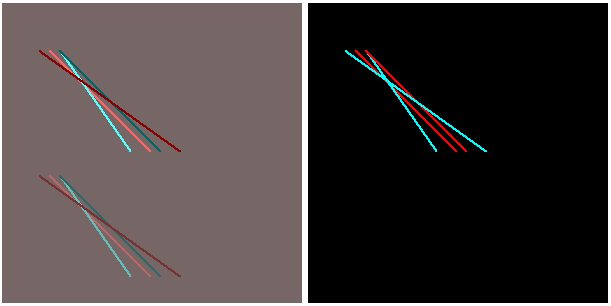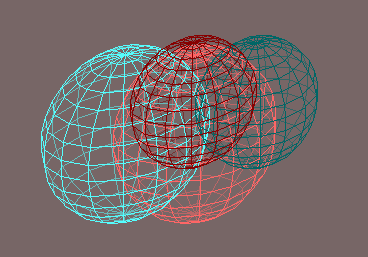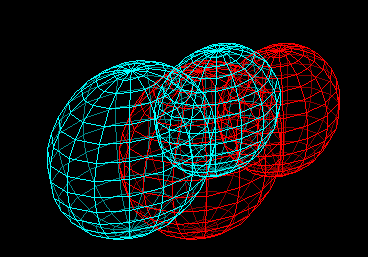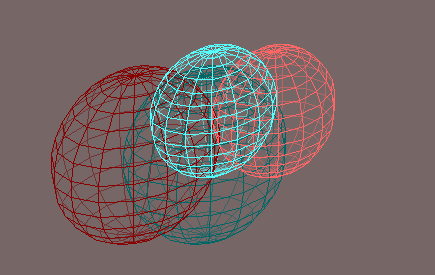

To use the proposed scheme one needs to choose a background color and four associated colors: a red_bright and red_dark, also a cyan_bright and cyan_dark. These should be chosen to maximize intensity contrast when seen though the matching filter (e.g when a red_bright or red_dark line is viewed through the red filter), but to be isoluminant with the background (and therefore invisible) when seen though the opposed filter (e.g when a cyan_bright or cyan_dark line is viewed through the red filter.) Suitable colors are readily revealed by a bit of experimentation with red-blue glasses. Although these colors will depend on the transmissivities of the filters used, the values background = 776666, red_bright = ff6666, cyan_bright = 55ffff, red_dark = 006666, cyan_dark = 880000 will often be found suitable. Since clutter can also be reduced by dimming the edges of the back-pointing faces of figures, one also wants to define colors for dimmed red and cyan bright and dark edges. The following values, which are used in the lower left-hand stereo line pair seen above, will often be suitable: red_bright_dim = bb6666, cyan_bright_dim = 66bbbb, red_dark_dim = 336666, cyan_dark_dim = 773333.
The three following test figures, which confirm the effectiveness of the scheme proposed in a more complex setting, show a pair of intersecting spheres. The first image presents these as a double anaglyph, one sphere being bright and the other dark. The second figure presents the same geometry as a standard black-background anaglyph. It will be noted that in the first figures both of the sphere surfaces remain clearly visible in the overlap area, whereas in the standard anaglyph the back surface of the frontmost sphere cannot be seen in the overlap area.
In the third figure, also a double anaglyph, the back surface of the forward (dark) sphere can be made out in the overlap area, but less assuredly than in the first presentation. This suggests the following rule: since figure elements get harder to see the farther back in anaglyphic space they lie, he rearmost elements which are to remain perceptible should be presented in the most salient way. In the image seen this calls for a bright-lines presentation.



To use the same technique in a glassless stereo setting (or in other stereo modes such as polarized or timed optical views), one has only to use a grey background and to present roughly half the scene components using white lines and the others using black. Our next figure presents the overlapping-spheres scene in this way. The front sphere remains visible in the overlap area. Comparison with an image in which the polarity of the two spheres is reversed will show that the image seen is clearer, as the rule stated above would suggest.
It is also worth noting that attention can be directed either to the white or the black sphere, even in the overlap area. This suggests that the bifurcation of visual perception mechanisms into partly separated darker-than-background and lighter-than-background streams carries through to the relatively late stages of processing at which attention can operate.

Our final image presents the two-spheres scene in glassless stereo, but without separation into dark and light scene components. Again it is seen that this makes it nearly impossible to see the back surface of the frontmost sphere in the overlap area.

The rear surface of the smaller sphere, which is three levels back in the overlap area, is not visible in any of our presentations.